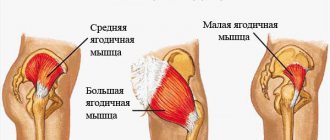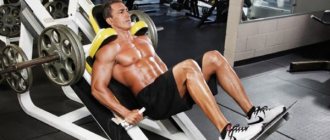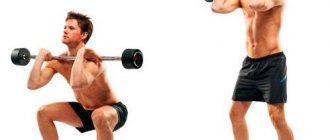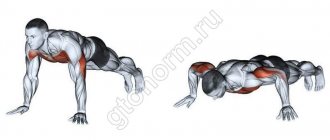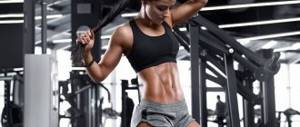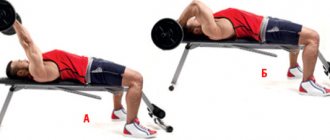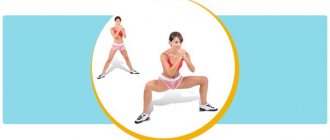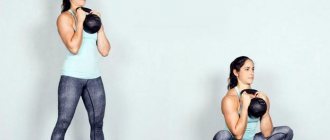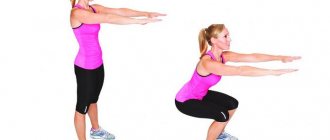The barbell squat is one of the most important exercises in the arsenal of any powerlifter or CrossFit follower. It involves almost all the muscles of the upper and lower belts, as well as stabilizer muscles. Based on the level of performance of this exercise, one can judge the athlete’s holistic strength training, since it is basic and technically necessary.
Squats with a barbell on the shoulders require the athlete to adhere to perfect technique. This point is critically important, since lifting heavy weights always carries a high risk of injury, sprain, or worse. In this article we will describe in detail the rules of squats with a barbell, give various variations of the exercise, and explain how to perform them correctly.
Benefits and harms
First, let's look at the pros and cons and find out what barbell squats do.
- This is the best exercise for athletes training to increase muscle mass. It allows you to form a beautiful relief, tone your muscles, and increase their strength;
- The athlete becomes more mobile, his coordination and endurance threshold improve;
- Exercise stimulates increased blood circulation in the pelvic area, which has a beneficial effect on the male reproductive system;
- Squats with heavy weights contribute to increased production of testosterone, which affects potency;
- Squats help get rid of subcutaneous fat in the lower body. In return, you get powerful and impressive muscles and a toned body;
- For women, squats with a barbell are useful for body shaping - they help pump up the buttocks, thighs, improve shape, and tighten the skin.
- Moderate load (light weight) helps strengthen joints and ligaments.
- Exercise helps increase physical strength, improve mood, raise self-esteem, and improve sleep quality.
If we talk about shortcomings, we note the following points:
- For most variations, athletes will need equipment, which means they won’t be able to practice at home;
- Beginners should practice with a trainer - we categorically do not recommend setting up the technique on your own;
- Squats with a barbell have a lot of contraindications (high load on the body);
- The exercise is potentially traumatic, so follow the technique carefully.
All harm comes down to the consequences due to improper execution of the latter.
- Athletes risk damaging their knee ligaments and joints. By the way, we recommend wrapping elastic bandages around your knees;
- Rip off the spine;
- Develop a vertebral hernia or protrusion;
- Injuries to the upper shoulder girdle often occur - you need to be able to hold the bar correctly;
- An increase in intra-abdominal pressure can cause an umbilical hernia, which is why it is worth wearing an athletic tape.
Features of this exercise
If you look at a person doing a squat with a barbell, you might think that there is nothing complicated about it, and any unprepared person can repeat it exactly. Since this is the exercise that is natural for your daily lifestyle. Undoubtedly, this movement is inherent in the human body by Mother Nature, but with age, our body begins to forget the ideal squatting technique.
Any type of squat is very good for shaping the lower body. It is one of the three main basic exercises, precisely because, when performed correctly, it involves a large number of muscles. Namely: buttocks, quadriceps, stabilizer muscles, hamstrings. In addition, squats are an exercise for effective mass gain (they make it possible to dynamically increase muscle mass). Also, due to the intense work of the human nervous system during squats, the secretion of somatotropin (growth hormone) and testosterone increases significantly.
Contraindications
Before we tell you how to properly squat with a barbell for men and women, we will introduce you to a list of contraindications. Read it very carefully:
- Any, even minor, problems with the spine;
- Diseases or injuries of the hip or knee joints, ligaments;
- Dorsal and abdominal hernias;
- Radiculitis and scoliosis;
- Acute diseases of the cardiovascular system;
- Conditions after a heart attack or stroke;
- Varicose veins;
- Glaucoma;
- Pregnancy;
- Recovery period after surgery or injury;
- Any exacerbation of chronic diseases;
- Inflammatory processes, increased body temperature;
- Bad feeling.
Safety precautions
Very soon we will begin to explain how to do squats with a barbell on hands, but first we need to talk about safety precautions. We hope there is no need to explain why this is necessary.
- Never exercise when you feel unwell, under the influence of alcohol or other intoxication, or if you feel acute pain in your muscles or ligaments;
- Always do a warm-up - squats with an apparatus on cold muscles - suicide for the latter;
- Work smoothly, without jerks or jolts;
- When squatting, do not lift your head up; you may lose your balance. Don't look down either. Ideally, look at yourself in the mirror, keeping your head and eyes straight;
- Exercise with equipment: elastic bandages, athletic belt, wristband, hard-soled shoes, comfortable clothes.
- When squatting with super-heavy weights, be sure to involve a partner as a backup. Or better yet, 2 or 3. Don’t hesitate to ask people in the gym for help if you come to study alone. Sports etiquette will not allow them to refuse you;
- Start with light weights and gradually add pancakes;
- Don't do too many repetitions (more than 6) as the axial load is too taxing on your back. The number of repetitions in one approach is 6-12.
As you can see, there are not very many rules and they are all adequate.
How and how many times to do it
The most important thing about front squats is technique. It will allow you to instruct you on how to perform the exercise correctly and without harm to the body.
Correct technique
At the moment, there are two known ways to perform the exercise: with the legs close and wide. Professionals recommend placing your feet shoulder-width apart.
Warm up and stretch your legs before performing squats. Make sure there is a mirror in the gym that will help you control yourself and avoid mistakes. One side mirror will not be enough; you need to see yourself from the front. Don't be distracted by anything to keep your balance and complete the approach without mistakes.
How to choose weight
Let's continue to study how to learn how to squat with a barbell and, finally, move on to practice. Let's find out how to choose the optimal weight.
There is a rule that allows you to choose the optimal starting weight for a beginner - “body weight - minus 15 kg.” That is, if an athlete weighs 85 kg, the initial weight of the equipment should not exceed 70 kg.
However, often people who visit the gym for the first time are so physically unprepared and, simply put, fat that the value obtained by using this formula turns out to be too high for them.
Professional trainers recommend starting with a weight of 40-50 kg, after which you need to do 10 repetitions. If the task is easy, place a 5 kg weight plate on both sides of the bar. Repeat the test. Continue throwing until you feel muscle failure at reps 6-8. This is your real working weight.
Other types of barbell squats
- squats with narrow legs;
- sumo squats;
- front squats;
- squats in the SMITH machine.
Let's look at each type in a little more detail.
Squats with narrow legs.
Unlike a simple classic squat, this type differs only in the placement of the legs. In this option, the legs are placed narrower than shoulder width. The entire technique for performing the exercise is identical to the first option. The muscles of the front surface of the thigh are included in the work, and the back surface of the thigh becomes auxiliary.
Sumo squats.
A very common option among amateurs and powerlifting athletes. The positioning of the legs also distinguishes it from the classics. Here it is wider than shoulder width, the toes are spread out to the sides. This position of the legs will allow you to work the internal muscles of the thigh and buttocks. You can often see a version of the sumo-style squat performed by girls, since it is the female gender that dreams of beautiful and slender legs.
Front squats.
Another type of squats, which has its own specific nuances. The bar in this case is located in front of you on the front delta beams. This exercise is very difficult technically, so it is not advisable for beginners to do it. The technique is very similar to a classic squat, only you need to move your body forward quite a bit. The weight for this type of squats should be less than for squats with a barbell on the shoulders. During the exercise, you use not only the muscles of the thighs and calves, but also the abdominal muscles and buttocks.
Varieties of hand positions on the bar during a front squat
Smith machine squats.
The Smith machine is a popular invention that allows you to do all types of squats in one place. The movement of the bar occurs only along one trajectory. This type of simulator is very suitable for beginners, since the risk of performing the exercise incorrectly is minimized. You just need to set the bar at the height you need. Grasp the bar with both hands and place it on your shoulders. Bring your feet forward a little and place them shoulder-width apart. When starting the downward movement, keep your back straight and your pelvis pulled back. Look only in front of you.
So we’ve sorted out all the key points, and let’s sum up some results. To squat correctly you need to remember the following:
- Don't forget to warm up before doing exercises. It is best to pay special attention to the knee joints and warming up the leg muscles;
- Perform no more than 10 repetitions with an empty bar, remember the correct squatting technique;
- Weight gain should occur gradually, from 30-80%;
- Don't forget about proper breathing. While inhaling we do a squat, while exhaling we do a rise;
- Always keep your shoulder blades retracted, press your heels firmly to the floor, keep your back straight and arched in the lower back;
- If necessary, do additional exercises that will strengthen the muscle corset;
- If your knee health allows you to do deep squats, you can include them in the program;
- Make all movements smoothly, without haste;
- For a beginner, the ideal option would be to do 3-4 sets of 8-10 repetitions;
- When squatting with heavy weights, it is better to use a special weightlifting belt. This will save equipment and relieve the load by about 10-20%.
By following all the recommendations, you will quickly learn how to squat, and you will even be able to compete with already “avid jocks”.
How to hold a barbell?
When squats, the barbell can be held on the shoulder blades, shoulders, front deltoid, but the most common and convenient option is the shoulders.
- According to the technique of performing back squats, the grip should be straight and closed. The width of the arms does not matter, but they are usually placed slightly wider than shoulder-width apart. They should be located on the fingerboard symmetrically from the edges. This is important for maintaining balance.
- The technique of squats with a barbell on the front allows you to hold the bar in a classic (hook-shaped) or cross way. The first involves symmetrically placing your hands under the bar away from you so that they look up. The grip turns out to be half-closed. In the second case, the arms are crossed on the bar, the grip is open.
Front Squats
The obvious difference between these types of squats is the placement of the barbell. When performing front squats, the bar lies in front of the athlete in his hands, on his shoulders, with his elbows raised high. When performing squats with a barbell on your shoulders, the bar lies on top of your back. When performing the first version of squats, the athlete is forced to keep his back straight so that the barbell is above the center of the foot and does not roll off the shoulders when performing squats.
A straight back allows you to avoid the appearance of kyphosis (hump) in the thoracic spine (this is a curvature that makes a person constantly slouch), but this is only if the elbows are raised as high as possible throughout the entire exercise.
The mechanics of the front squat make it extremely demanding on the quads, abs, and knees, while reducing stress on the glutes and hips. A 2009 study published in the Journal of Strength and Conditioning Research found that front squats exert much less “compressive load” than shoulder squats.
But because the front squat puts most of the load on the quads and knees, rather than on the stronger glutes and hamstrings like the front squat does, the front squat will always be (at least they should be) “weaker” than back squats.
Additionally, the very placement of the bar in front squats (even though the bar rests more heavily on the front of the deltoids) puts the upper body muscles at a disadvantage compared to shoulder squats. It is very difficult to hold a lot of weight in front of the neck, and it is simply impossible to transfer as much energy and impact to the bar as is possible with the bar on the back.
Finally, the front squat requires the athlete to develop flexibility in the wrists, shoulders, ankles, and hips. And the fact that you have to keep your back straight means that you won’t be able to “cheat” like with squats with a barbell on your shoulders, when you can bend a little forward to help yourself lift the weight up. All these reasons together explain why the same athlete’s squats with a barbell on his shoulders are “stronger” than squats with a barbell on his front.
But despite all this, the front squat is an excellent exercise that develops flexibility and increases quadriceps and core strength. In addition, it is safe for those who cannot yet boast of developed physical fitness, because the barbell can simply be thrown forward, away from you.
In addition, front squats have a positive effect on the successful performance of classic weightlifting exercises (the squat and rise during the clean are, in fact, the front squat) and in this context they are more useful than barbell squats on the back.
In fact, imagine all those exercises where you have to hold a barbell on your shoulders in front of you - clean, power clean, push press, push push, scissor push, thrusters, etc.. So the easier it is for you If such a position is given, the higher your results in these exercises will be.
What muscles work?
To help you better understand the biomechanics of barbell squats, let’s find out which muscles work during the process:
- The main load is received by the quadriceps (quadriceps) and gluteus maximus (the one responsible for the round butt);
- Stabilize the position of the back extensors, hamstrings, soleus, and gastrocnemius;
- The abdominal muscles (straight and oblique abdomen), as well as the deltoids, receive a secondary load;
- The knee, hip and calf joints, as well as the back and shoulders, are actively working.
Well, we have clarified what squats do with a barbell, as you can see - this is an ideal exercise for building spectacular legs and round buttocks. Let's finally move on to technology!
What muscles are pumped?
During the exercise, the muscles of the hips, abdomen, legs, buttocks, and arms are involved. But they strain with different strength: some are very strong, others only perform an auxiliary function.
Basic
The main muscle in the front squat is the quadriceps muscle on the thighs.
Additional
The auxiliary muscles that can be used to perform a front squat are the gastrocnemius, gluteal, biceps, semimembranosus, and hamstrings.
The following muscles swing in the same direction: gluteus maximus, adductor, soleus. The function of dynamic stabilizers is performed by the muscles located in the back of the thigh, the calf muscles. The stabilizing function is performed by the rectus and oblique muscles, located on the abdomen.
By being in an upright position with a load (barbell), you are already activating almost all of the back muscles, which help keep the whole body in the correct position. When performing a front squat, all the leg muscles that exist work.
Did you know? In 1978, the first women's bodybuilding competition was held in America.
Classic barbell squat technique
Let's first look at the basic technique of performing squats with a barbell for men and women, and then add separate recommendations for each of the variations of the exercise.
Be sure to warm up your entire body thoroughly with a set of cardio exercises. Do several sets of empty bar squats.
Basic technique
The optimal height of the barbell is the level of the athlete’s collarbones.
- Stand under the bar, squat slightly, bending at the waist (without rounding your back), place the barbell on the trapezius, and remove it from the racks. Take a couple of steps back so as not to touch the frame during squats;
- The starting position for most types of barbell squats for men and women is the same: feet shoulder-width apart, hands on the bar, elbows back, back straight, shoulder blades pulled together, abs tense, gaze forward.
- Don't forget about proper breathing when squats. As you inhale, begin to slowly lower yourself until your thighs are parallel to the floor. The pelvis is pulled back and the knees are separated. At the same time, the back bends, due to which the body leans slightly forward. It is important to distinguish between natural leaning and excessive leaning.
- As you exhale, slowly rise up, returning to the starting position.
Please note that the depth of the squat affects the difficulty of the exercise. If you squat below parallel, your buttocks and back will be more stressed. However, we recommend that beginners start practicing from the golden mean, which is the lowest point at which the lower leg and thigh form a right angle.
Variations
So, we have figured out how to do classic squats with a barbell, now let's move on to other variations. By the way, the basic principles of the technique remain similar, but there are nuances.
- Barbell squats with narrow leg stance. Due to it, the quadriceps, as well as the outer surface of the thigh, are more actively involved. This variation will not allow you to work at full amplitude, so the maximum depth of the squat will be parallel. There are no differences in technology.
- Squats with a barbell with wide legs. The most commonly practiced exercise in this category is sumo squats. The direction of the load on specific muscles depends on the correct positioning of the legs when squatting with a barbell. In this case, the muscles of the inner thigh, as well as the gluteal muscles, work stronger. The main nuance of the technique is that the socks need to be turned out as wide as the stretch allows you. They should look strictly in the same direction as their knees.
- Front squats. It is impossible to work with super-heavy weights with them, so this subtype is not intended for records. The technique of performing a squat with a barbell on the sternum only at first glance seems different from the algorithm in the classic version. This is because the bar is in front. However, in essence, this is the only difference. Oh, yes - the body tilt here is less deep, otherwise the athlete will simply fall forward. If you are wondering what muscles are involved in front squats with a barbell, we will emphasize that the muscles of the front of the thigh receive the greatest load.
- Squats with a barbell on a Smith machine. This is a special frame in which the bar is fixed and can only move up and down. The main advantage of this simulator is that the athlete does not need to control balance or monitor the amplitude of the tilt. Therefore he feels more secure and comfortable. We recommend that beginners squat in Smith. The technique, by the way, remains similar to the algorithm for working in a conventional frame. Unless you remove the bar with a rotational motion. The Smith machine can be used to do any type of barbell squat: front, classic, wide or narrow.
Common mistakes
The correct barbell squat technique for men and women does not accept the following mistakes:
- Rounding of the back;
- Lifting the heels off the floor, and thereby transferring the weight to the toes;
- The knees go beyond the line of the socks;
- The knees are brought together;
- Toes and knees point in different directions (not parallel);
- Lifting by pushing your tailbone up, and not by using the strength of your leg muscles alone;
- Breathing irregularly, holding your breath, rising while inhaling;
- Working on cold muscles or feeling unwell;
- Extreme weight or working without a supporter.
99% of all these mistakes lead to injury!
So, we have looked at the basic technique of performing squats with a barbell on the shoulders or chest for men and women. Now the time has come to move from theory to practice. Below is a sample workout diagram for beginners.
How to do classic squats with a barbell?
Step by step basic technique
- Before the approach, prepare mentally, focus and concentrate on the weight you are lifting.
- Before squats, warm up your body with cardio exercises. The first set begins with several approaches with minimal weights.
- Approach the barbell located at the level of your collarbones. Grasp the bar with a straight closed grip. Choose a comfortable width for your palms, usually slightly wider than your shoulders: this way your shoulder blades will remain retracted and your back straight throughout the entire approach. If your shoulder joints are tight, spread your arms wider, although this grip increases the likelihood of losing balance.
- Squeeze the bar tightly with your palms, bend your knees slightly and step forward. Walk under the barbell, plant your other foot, and lift up until your shoulder blades are together and the bar is resting on your upper back. With the correct technique, the weight will fall on the trapezius muscle and will be supported by the rear deltoids. If there is strong pressure on the vertebrae, return to the starting position and repeat the approach to the barbell.
- Tighten your leg muscles, straighten your knees, and release the weight from the supports. Take a small step back and place your other foot. Take a neutral head position - this makes it easier to keep your lower back arched and reduces the risk of losing balance. Place your feet wider than shoulder-width apart and point your toes slightly out to the sides. Fix the position and concentrate as much as possible before squatting.
- While inhaling deeply, move your pelvis back and spread your knees to the sides. Do not “lean” forward; a natural tilt of the body is enough. A proper squat is like lowering your buttocks onto an imaginary chair. Having descended to the lowest point, immediately rise and exhale the air from your lungs. The lifting technique is by straightening the legs, and not by straightening the back.
Studies from the University of Alabama (USA) and a number of other specialized organizations have not revealed any harm from barbell squats for the knee joints with the correct technique, neither in professional athletes nor in amateurs.
Important nuances
Boom position
If you lower the bar below your back deltoids, the load will shift to your glutes. This method is suitable for girls with light squats, but is not suitable for strength training, as it increases forward bending and the risk of losing balance.
Head position
The head continues the line of the spine. The gaze is fixed straight ahead.
Squat depth
The depth of the squat affects the involvement of the muscles of the lower back and buttocks. It is determined by how much you can arch your spine without lifting your heels off the floor. The deeper the squat, the greater the load on them. Increasing the range of motion increases strength. To gain muscle mass, weightlifters are recommended to go as low as possible to the horizontal position of their hips.
Knee position
The main rule for a safe squat is that the knee joints should not extend beyond the toes, otherwise the knee ligaments will be injured. To do this, the pelvis is pulled back. Practice proper technique without weight before performing an exercise with weights.
Foot position
The wider your legs are, the greater the load on the buttock muscles. When doing strength training, it is recommended to place your feet at shoulder level or slightly wider. The socks are turned in the same direction as the knees.
Weight selection
When selecting weights, they are guided by the rule: for muscle growth, 6-12 repetitions are needed in each approach, and failure should occur on the last two repetitions.
For example, if you are a beginner athlete, then 10 repetitions per set is enough. Try to perform them using the correct technique with a working weight of 40-50 kg - this is a bar with two weights of 10 kg on each side. If failure occurs after the 8-9th squat, the weight is selected correctly. If you completed all 10 squats easily, add a 5 kg plate to each side. Add weight in this manner until you reach failure on the 8th squat.
Front squat
The safest alternative to classic barbell squats. Reduces the level of interarticular tension in the knees by 15% without loss of muscle activity. Stimulates the quadriceps, facilitates back alignment, the squat is effective even with small loads, and allows you to quickly achieve results.
The exercise helps build strength, flexibility and mobility.
The technique differs from the classic one in that the barbell is held on the chest with the elbows raised as much as possible: the humerus should be parallel to the floor.
Squats for older athletes
Additional precautions are required: thorough warm-up, adherence to exercise technique and safety precautions. In this case, injury rates and rehabilitation are the same as for younger athletes.
Dangerous mistakes that cause injuries:
- brush crease;
- rounding of the spine, lack of arching in the lower back;
- lack of tension in the abdominal muscles;
- bringing the knees inward;
- lifting the heels and transferring body weight to the toes;
- lifting the barbell not by straightening the legs at the knees, but by straightening the back;
- small distance between feet.
If you feel pain during exercise, stop exercising, take an anti-inflammatory pain reliever, and refrain from physical activity for 3-7 days. If the pain does not go away, consult a doctor.
Lesson program
Many people believe that it is enough to take a ready-made squat scheme without a barbell and follow it, but with a projectile. This opinion is critically erroneous, since in such programs, as a rule, a large number of repetitions is indicated in each approach. When working with weights, the main thing is not quantity, but quality. Therefore, there are fewer squats, but the efficiency is many times greater. Here is a good scheme that will suit both men and women:
- Day 1. 2 sets of 5 squats with a barbell on the shoulders;
- Day 2. Rest.
- Day 3. 2 sets of 5 squats with a barbell on the shoulders, 1 set of front squats;
- Day 4. Rest.
- Day 5. 2 sets of 7 squats, barbell on shoulders; 2 sets of 7 times, barbell on the sternum;
- Day 6-7. Rest.
In the second week, we listen to our feelings. If it’s hard, repeat the previous scheme. If everything is OK, add 3-5 repetitions in each approach.
In the third week, you can connect several approaches in other variations of squats (narrow, wide, lunges, etc.), depending on the goal being pursued.
In the fourth and further weeks, when the number of repetitions increases to 10-12, and approaches to 4-6, you can begin to increase the weight.
Now let's talk about how to replace barbell squats.
Rules for performing the exercise
- For safety reasons, this exercise is best performed in a squat rack. Set the barbell according to your height. Choose the appropriate weight. Stand under the barbell so that it rests on your shoulders (just below your neck).
- Hold the bar with both hands and lift it off the rack. To do this, push off with your feet and straighten your torso at the same time.
- Step away from the counter and place your feet wider than shoulder-width apart, with your toes slightly turned out to the sides. Keep your back straight. Your head is always raised; if you look down, you will lose your balance. This is the starting position.
- As you inhale, slowly squat, tilting your body forward slightly. Continue lowering until your shin and thigh form a right angle. Important: when performed correctly, the knees and toes are in line. If your knees extend beyond your toes, you are not using proper technique and are putting excessive stress on your knee joints.
- As you exhale, rise back to the starting position, transferring your weight to your heels.
- Repeat as many times as necessary. Warning: This exercise should be taken extremely seriously. If you have back problems, replace it with dumbbell squats or leg presses. If you are healthy, then pay attention to your technique and do not tilt your body back or forward, as this can cause a back injury. Also be careful with the weight, if there is any doubt, it is better to take a lighter weight. Squats are a safe exercise only if proper technique is followed. Variations: There are different variations of this exercise, depending on the goal.
- If your ankles are not flexible enough, you can place a small block under your heels.
- To add weight, you can work with dumbbells in your hands. If you carry a lot of weight, be sure to use wrist straps. (Note: For wide-legged squats, hold the dumbbells between your legs, not at the sides of your thighs.)
- Another way is to use a power belt and attach a weight to it, which will be lowered between your legs. This option is called belt squats. Here the feet are placed on two stable platforms so that the weight can be lowered between them. This option is great for those who have lower back problems.
Alternative Exercises
Alternative
If for health reasons you cannot do squats with a barbell in a regular rack, exercise in a Smith machine. As we wrote above, it solves problems with coordination and balance. Another cool machine is the Hackenschmidt simulator. Hack squats minimize stress on your back and knees while still allowing you to lift substantial weights. There is another exercise that is similar in mechanics to squats - the leg press. In this case, there is also no work of the spine - only the legs. Another alternative would be lunges with a barbell - with them there is an axial load, but the working weight is much lower than in the classics.
Analysis of the exercise squatting with a barbell in front of you or on your shoulders is considered complete. We tried to cover all possible aspects of the topic, provided recommendations, and introduced you to the nuances. We recommend that you re-read the safety precautions and contraindications. Happy training!
Execution technique
Despite the apparent ease of execution, do not be deceived - front squats require clear technique and basic training.
It is necessary to distinguish between two versions of squats with a barbell on hands,
the fundamental difference of which is in holding the barbell. The method used in weightlifting training is with a direct grip on the bar; in classical bodybuilding, a cross grip is used. Please note that it is not recommended to lift heavy weights with a cross grip.
The technique of performing the squats themselves is completely identical in both variations of the exercise and consists of the following main stages:
- The bar should be positioned on the rack holders at shoulder level;
- Approach the rack and squat slightly, placing your shoulders under the bar;
- Using a firm grip, fix the barbell on your chest in the area of the front delts;
- The grip of the barbell during a weightlifting squat should be slightly wider than the shoulders; in the version used in bodybuilding, the distance between crossed palms should be no more than 15-20 cm;
- The feet should be positioned shoulder-width apart, the vertebrae straight, toes turned out;
- Elbows should be directed forward, parallel to the floor;
- Perform controlled deep squats, returning to the starting position as quickly as possible.
- Before starting the exercise, take a deep breath, exhale during the descent and return ascent.
Common mistakes:
- Changing the position of the elbows as you approach the bottom point;
- Deflections in the vertebra;
- Lifting heels off the floor;
- Bringing the knees together when returning to the starting position;
- Incorrect technique or holding your breath.
